|
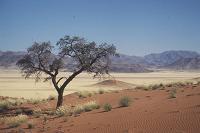 The
country’s name derived from the Namib Desert, which stretches from
the Oranje River north along the Atlantic Ocean right into Angola. The
country’s name derived from the Namib Desert, which stretches from
the Oranje River north along the Atlantic Ocean right into Angola.
Although
it is the oldest desert in the world it is far from being lifeless and
barren. The long costal desert features an unusual variety of
desert-adapted fauna and flora, which includes a large number of
endemic plants, reptiles, insects, and bird species.
Main
tourist attractions like the Sossusvlei, Sandwich Harbour and Skeleton
Coast Park are within the Namib Desert.
Windhoek
is Namibia’s capital with a multicultural population of 170 000
people.
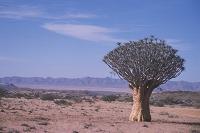 The
abundance of wildlife, scenic beauty, the bountiful sunshine and the
diversity of geological phenomena make Namibia a sought-after tourist
destination. The friendliness and cultural diversity add to this. The
abundance of wildlife, scenic beauty, the bountiful sunshine and the
diversity of geological phenomena make Namibia a sought-after tourist
destination. The friendliness and cultural diversity add to this.
With a size of 824 268km² it is a vast country with ever changing
sceneries, offering a well-developed infrastructure.
Namibia borders on Botswana in the east, South Africa in the south,
the Atlantic Ocean in the west and Angola, Zambia and Zimbabwe in the
north.
Namibia
can be divided into four distinct topographical regions - the Namib
Desert, the Central Plateau, the Kalahari Desert and the tropical
forest and woodland savannah of the Kavango and the Caprivi.
All
five perennial rivers lie on the borders of Namibia. These are the
Oranje River, Kunene, Okavango, Zambezi
and Kwando/Linyanti/Chobe.
Noteworthy
seasonal rivers are the Fish and Nossob in the South, Kuiseb, Swakop,
Omaruru, Hoarusib, Hoanib, Ugab and Khumib in the west, as well as the
Cuvelai, as the source to the Etosha Pan, coming from southern Angola.
History:
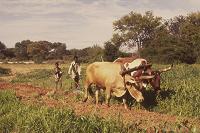 In
1805 the first white missionaries came into the country. In
1805 the first white missionaries came into the country.
Fürst
Bismark proclaimed the country a German protectorate in 1884. The
conquest of German South West Africa by South African forces
during World War I resulted in its administration by South Africa
under a 1920 League of Nations mandate.
In
1966 the liberation movement between the occupying South African
forces and the SWAPO (South West African People’s Organisation)
started.
In
1989 the implementation of the United Nations Resolution 435 for
free and fair elections resulted in SWAPO coming to power with
independence on 21 March 1990.
Dr Sam Nujma become Namibia’s first president and served three
terms. He was followed by Mr. Hifikepunye Pohamba in March 2005.
Namibia
is ruled by a multiparty parliament and has a democratic
constitution. The
Government’s policy of national reconciliation and unity
embraces the concepts of tolerance, respect for different
political views, and racial and ethnic harmony.
Population:
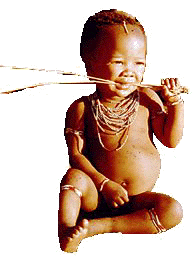 According
the last census in 2001 Namibia had a population of 1,8 million.
This means a population density of less than two people per square
metre, which is one of the lowest in the world. According
the last census in 2001 Namibia had a population of 1,8 million.
This means a population density of less than two people per square
metre, which is one of the lowest in the world.
The
population consists of 86% Black, 6.6%White and 7,4% Half-breds.
The black population could be divided as follows: 50% Ovambo, 9%
Kavangos, 9% Herero,
7% Damara, 5% Nama, 4% Caperivians, 3% Busmen 2% Bastards and 0,5
Tswana.
The
annual growth rates is ±2,6%.
English
is the official language, but many native languages are spoken (Owambo,
Herero, Damara, Nama, etc) as well as Afrikaans and German.
Religion:
80% of the population are Christians.
Climate:
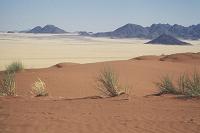 As
Namibia is a semi-desert country it has a dry climate where
droughts occur regularly. This phenomenon is greatly influenced by
the cold Benguela current in the Atlantic Ocean. As
Namibia is a semi-desert country it has a dry climate where
droughts occur regularly. This phenomenon is greatly influenced by
the cold Benguela current in the Atlantic Ocean.
Days
are mostly warm to very hot, while nights are generally cool.
In
summer (October to April) the average temperatures range from 20°C
to 34°C during the day.
In
winter nigh - time temperatures can drop below freezing point and
ground frosts do occur. The day - time temperatures in the
interior range from 18°C - 25°C
The
rainy season is from October to May, but mostly it rains from
January to March.
Rainfall
is usually caused by convection thunderstorms, which are normally
of a short duration.
The
average rainfall figures vary from less than 50mm along the coast
to 350 mm in the central and 700mm in the far north - eastern
regions.
Winter
rains do occur in the far south - westerly regions.
Often
the coast is covered by thick mist.
Parks:
Namibia
has several national parks as well as a few private parks.
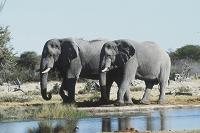 In
the north of Namibia we find the world-famous Etosha National Park,
with a size of 22 270km² it is one of the
largest game parks in Africa. In
the north of Namibia we find the world-famous Etosha National Park,
with a size of 22 270km² it is one of the
largest game parks in Africa.
Etosha owes its unique
landscape to the Etosha Pan, a vast shallow depression of
approximately 5 000km². A series of waterholes along the southern
edge of the pan guarantees rewarding and often spectacular game
viewing. Several of the 114 mammal species found in the park are rare
and/or endangered, including the black rhino and black-faced impala.
Over 340 bird species have been recorded at Etosha.
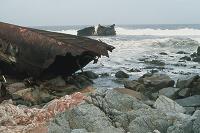 The Skeleton Coast Park
was proclaimed in its present form in 1973. It extends from the Ugab
River in the south to the Kunene River in the North. The Skeleton Coast Park
was proclaimed in its present form in 1973. It extends from the Ugab
River in the south to the Kunene River in the North.
The attraction of this remote
area lies mainly in the colour changing moods and untouched profile of
its landscape, ranging from sweeping vistas of windswept dunes to
rugged canyons with walls of richly coloured volcanic rock and
extensive mountain ranges.
Its aura of mystery and
impenetrability is due to the many shipwrecks, the dense coastal fog
and rough sea-swell.
The Namib - Naukluft Park
in the south - western part of the country is Namibia’s mist
versatile conservation area comprising an area of almost 50 000km².
This includes key features like the Sossusvlei, Sesriem Canyon,
Sandwich Harbour, the Naukluft mountains and the Kuiseb Canyon.
In the north - east of the
country, in the Caprivi, we
find the Mahango and the Mudumu National Park. Both
parks boast with a variety of game, like elephant, buffalo, hippos,
letchwe and the sable antelope.
These areas are a
birdwatcher’s paradise, with over 400 species.
The Waterberg Plateau Park
in the central of the country, rises 200m above the surrounding area,
with flamboyant brick-red sandstone formations and lush green
vegetation.
This park is home to some 25
game and over 200 bird species, and hosts a great variety of
vegetation, like fern and an impressive range of flowering plants.
Some of the private nature
parks are the NamibRand Nature Reserve, situated south of
Sesriem, the Gondwana Cañon Park at the Fish River Canyon and
the Huab Private Nature Park near Kamanjab.
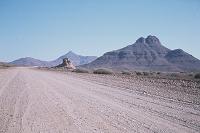 Economy: Economy:
Namibia’s economy is based mainly on mining, fishing, tourism and
agriculture. Of this tourism is the fasted growing industry, while
agriculture is the largest provider of employment.
Currency:
The Namibian Dollar and the South
African Rand are the excepted currencies in Namibia.
Foreign currency and
traveler’s cheques can be exchanged at all commercial banks in major
towns.
Credit Cards – International
Visa and MasterCard credit cards are widely accepted.
Infrastructure:
The country has a well-established road
network, mainly gravel roads, providing access to the majority of
towns, parks, nature reserves and tourist attractions.
Rail links to the major towns
are provided.
Namibia has two harbours, Walvis Bay and Lüderitz.
Next to Hosea Kutako International Airport, Namibia has several other
well equipped airports.
Large parts of the country are
covered by network of telephone lines. Cellphone coverage is proved to
all major towns in Namibia as well as along some of the national
highways.
Medical care is provided by
state-run hospitals in all major centers. Some towns have privately
run hospitals with good medical care.
Entry requirements:
Foreign visitors to Namibia require a passport, which is valid for at
least six months after the date of entry, and if required a valid visa.
As regulations change all the
time it is on the traveler to ensure that he/she is in the possession
of the necessary travel documents, and SUNBIRD TOURS cannot be held
responsible for any faulty documents.
Health requirements:
No vaccinations are required, but the northern parts of Namibia,
including the Etosha National Park are malaria-endemic areas. Please
consult your doctor for the correct prophylactics.
What to pack:
Cotton rather than synthetic clothing is recommended for Namibian
summers.
Winters are usually mild to
warm, which calls for light clothing in the middle of the day, and a
sweater or jacket for the evenings and early mornings when it can
become quite cold. It can be quite cold and windy at the coast, for
which warm clothing, including a windbreaker, is necessary. An
important item is comfortable walking shoes. Swimsuits are required
for public beaches or swimming pools.
When packing, remember to
include binoculars, a sun-hat, sunglasses, sun block, bathing towel,
moisturizer, lip-ice and mosquito repellents.
Bring enough film material.
Electricity (250VAC) is
available at most accommodations.
|
